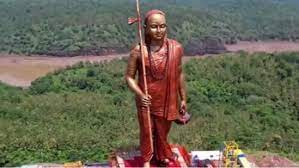
108 feet statue of Adiguru Shankaracharya unveiled in Omkareshwar
108 feet statue of Adiguru Shankaracharya unveiled in Omkareshwar
This topic is related IAS/PCS Prelims Exam Current Affairs and Main Exam General Studies Question Paper 1 Indian Art and Culture.
September 26, 2023
In News:
- Recently, a 108 feet statue of Adiguru Shankaracharya installed on Omkar Mountain was unveiled in Omkareshwar.
- Advaita Lok (Shankar Museum) is being constructed on 11.5hectare land of Omkar Mountain (also called Mandhata Mountain). The statue of Adiguru Shankaracharya has been installed in the middle of this.
- Acharya Shankar International Advaita Vedanta Institute is also being established in this area.
About the statue:
- This 108 feet high statue is a symbol of unity. It has been named 'Statue of Oneness'.
- This idol has been established on a 16 feet lotus made of stone in the middle of Advaita Lok (Shankar Museum).
- This statue of Adi Shankaracharya depicts the image of 12year old Acharya Shankar.
- This statue weighs 100 tons and is installed on a 75 feet high platform.
- This statue is made by mixing 88% copper, 4% zinc and 8% tin.
- 290 panels of this statue have been manufactured by L&T Company.
- This statue has been adorned with a 112 feet long garland brought from Sringeri Sharada Peeth, Chikmagalur, Karnataka. This garland is made of 10 thousand five faced Rudraksha.
About Adiguru Shankaracharya:
- Shankaracharya was born in Kaladi village of Kerala in 508-9 BC and attained Mahasamadhi in 477 BC. His mother's name was Aryamba and father's name was Shivguru.
- At the age of 32, he established four Peethas in four directions of the country: Badrinath Peetha (Uttarakhand), Sringeri Peetha (Karnataka), Dwarka Sharda Peetha (Gujarat) and Puri Govardhan Peetha (Orissa).
- These four Peethas are considered very famous and sacred even today.
- The purpose of establishing these four Peethas was to culturally connect the whole of India from North to South and East to West.
- With the aim of continuously maintaining the tradition of cultural unity and propagation of Advaita Vedanta philosophy, the West Peetha is the East, the East is on the back of the West, similarly the North is on the back of the South and the South is on the back of the North. Priests perform puja.
- Adi Shankaracharya made an uninterrupted journey across the country three times. His aim was to re-establish Sanatan Dharma. He is considered to be an incarnation of Shankar. He has given a very detailed and interesting explanation of Brahma Sutras.
- According to his philosophy, God exists in both Saguna and Nirguna forms at the same time.
- Adi Shankaracharya had established many temples and Shaktipeeths in India.
- These include: Chandi Devi Temple in Neel Parvat, Mata Hing Laj Temple (in Pakistan).
- In order to maintain cultural unity and the tradition of propagating Advaita Vedanta philosophy, the Purba Peetha is worshiped by the priest of the West, the West Peetha by the priest of the East, the South Peetha by the priest of the North and in the North Peetha the puja is performed by the priest of the South.
Adi Shankaracharya's relation with Madhya Pradesh:
- Adi Shankaracharya visited Kerala, Tamil Nadu, Andhra Pradesh, Karnataka, Maharashtra and Omkareshwar (Madhya Pradesh) at the age of 8.
- Adi Shankaracharya studied Vedas and Upanishads under the guidance of Guru Govind Bhagwat Pad in Omkareshwar and then at the age of 11, he set out on a tour of Akhand Bharat with the aim of re-establishing Advaitava Darshan and Sanatan Dharma.
- Adi Shankaracharya had touched Panchmatha of four places in Madhya Pradesh, Omkareshwar, Amarkantak, Ujjain and Rewa.
- He composed Narmada Ashtakam in Omkareshwar.
- Adi Shankaracharya wanted to establish the fifth matha in the ashram on the banks of river Beehar in Rewa, but due to his demise in 477 BC, this matha could not be built. At Present, this place is called Panchmatha.
Famous temples of Omkareshwar:
- Rinmukteshwar Mahadev Temple, Gayatri Mata Temple, Siddhanath Gauri Somnath Temple, Mata Vaishnodevi Temple, Brahmeshwar Temple, Gajanan Maharaj Temple of Segaon, Narsingh Tekri Temple, Kubereshwar Mahadev, Chandramoleshwar Mahadev.
- Most of the temples of Madhya Pradesh have been built in Nagara style.
Significance:
- Its construction will give a huge boost to tourism.
- Business will get manifold benefits financially.
- Its biggest benefit will be in the form of employment to the common people.
- It will help in maintaining the religious, cultural and traditional activities of the country continuously.
-----------------------------------
mains exam question
Adi Shankaracharya had revived religious, cultural and traditional practices in the country. Discuss.